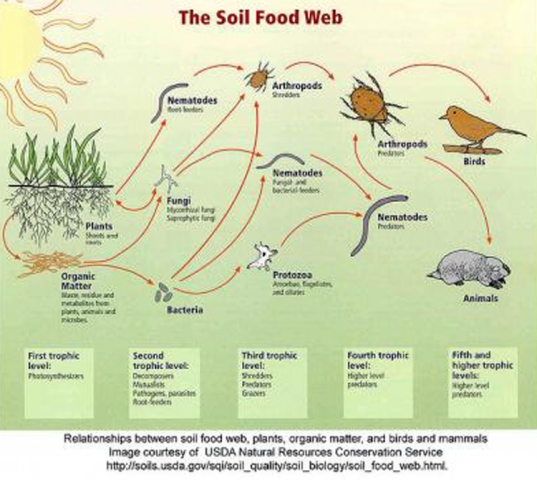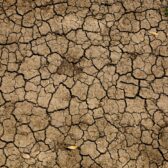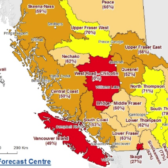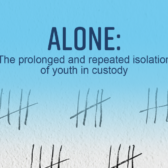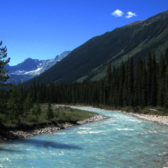The story of soil
There are two permaculture events led by Rob Avis of Verge Permaculture that Mountain Waters Retreats in Nelson is sponsoring this weekend. The following is the second of two articles highlighting the need and giving insight into permaculture.
By Rob Avis, Verge Permaculture
What is the difference between soil and dirt?
Soil is alive. Dirt is dead. A single teaspoon of soil can contain billions of microscopic bacteria, fungi, protozoa and nematodes.
A handful of the same soil will contain numerous earthworms, arthropods, and other visible crawling creatures. Healthy soil is a complex community of life and actually supports the most biodiverse ecosystem on the planet.
Modern soil science is demonstrating that these billions of living organisms are continuously at work, creating soil structure, producing nutrients and building defence systems against disease. In fact, it has been shown that the health of the soil community is key to the health of our plants, our food and our bodies.
Why is it then, that much of the food from the conventional agricultural system is grown in dirt? The plants grown in this lifeless soil are dependent on fertilizer and biocide inputs, chemicals which further destroy water quality, soil health and nutritional content.
How did we get here? How do we turn this around? This is the Story of Soil…
Turning and Ploughing Soil
It all started about 10,000 years ago when humans started ploughing the fields in the experiment called agriculture.
The settlers noticed that when they ploughed the field their crops would grow faster. Based on this positive feedback it was concluded that ploughing must be constructive and more fields were turned.
However, in actual fact the bacteria, fungi and arthropods in the soil are essentially nutrient locked up in biology. For example, bacteria is almost 90 per cent nitrogen. Ploughing the soil was killing the life in the soil resulting in an unregulated jolt of nutrient available to the surrounding plants.
Over time, with the death of all soil microbes, the soil is unable to naturally support life and the farmer had to move to more fertile ground. The agricultural pattern emerged: deforest, plough, irrigate, salinate, desertify, move on.
How the Synthesis of Acid Changed the World
About 150 years ago humans discovered how to synthesize sulphuric acid. The synthesis of acid allowed for a major advance in industrial agriculture: the ability to dissolve rock minerals into a water-soluble form.
This meant that macro-nutrients such as nitrogen (N), potassium (P) and phosphorus (K) could be added to the soil in a form that could be taken up by plants.
As acid was discovered at around the same time as petroleum, this meant the advent of harder, faster and larger-scale ploughing with the use of water soluble salt-based minerals. Again, what could be wrong with a system that produces so much?
Plants and Their Roots
Plants have two main types of roots: tap roots and hair roots. Tap roots are responsible for hydrating the plant, i.e. drinking water.
Soil does not freely feed or give minerals (such as calcium, magnesium, etc) to plants and so in order to get minerals a plant must make a “trade” with the soil biota – this is the primary function of the hair roots.
Therefore the hair roots are the mineral traders and create an environment around themselves called the rhizosphere — a habitat for soil biota.
Through the process of photosynthesis plants produce exudates (sugars) and commit up to fifty percent of these sugars to the action of feeding and trading with the biology in the soil.
When the plant needs a certain mineral, say calcium, it offers exudates to the biota that can provide calcium. This is a symbiotic process in which the plants support the biota and the biota support the plant.
And so, if you plough soil and kill off the biota and soil microorganisms, how does a plant get minerals? The industrial solution is to feed the minerals to the tap roots, i.e. put water-soluble dissolved minerals in the drinking water, otherwise known as fertilizer.
The advent of nitrogen, potassium and phosphorus fertilizer (NPK) meant that we did not need to rely on a bank of soil biology to make our plants grow. We could add macro-nutrients at whatever rate we desired and grow plants faster and quicker than ever before – in increasingly lifeless soil.
Have you ever salted a slug? What happens? The salt creates a large osmotic pressure on the creature’s cell wall and results in death. This analogy can be used to understand what happens to the soil biology when salt-based fertilizer is used (note that all fertilizer is based in mineral salts).
So the salting of the land through broad-acre fertilization ensures that the biology is completely dead. As long as we keep applying fertilizer there is no chance for life to return.
Without life in the soil, no natural mineral exchange can occur. Also, with plants being forced to drink mineral soup through the tap root, less energy is devoted to developing an overall healthy root structure. Fertilizer has become an addictive drug.
It has eliminated the soil biota, replaced that function in the ecosystem, and now must be continually applied. Whoever controls the fertilizer market secured their market share the same way as the cocaine dealer.
The Downward Spiral
By the late 1950s farmers were using NPK at record levels, tractors were highly advanced and the soils in the world were on a fast track to doom.
The use of mono-culture crops, heavy tilling, irrigation and fertilizer was killing the soil and making our plants weak and addicted to chemicals.
Monocrops of these obese and sick plants became an all-you-can-eat buffet for pests and the degraded and depleted soils a great opportunity for pioneer species (i.e. weeds).
“No worries!” proclaimed the Chemical Companies, “we’ve got the solution for that too”. Let’s kill these pests and nasty weeds that are causing all the problems – and thus pesticides and herbicides were born.
Without healthy soils to support beneficial fungal population the next problem to emerge for farmers was fungal issues. The “next solution” – apply fungicide!
We are now left with dead, acidic and salted soils that are only good for holding up plants.
Weeds and What they Tell
Carbon is the building block of life. Any soil scientist, gardener or farmer will tell you that a soil with no carbon is a dead soil.
Carbon and nitrogen like to bond together at a rate of 30:1 and most gardeners know that mixing too much carbon into (like mulch or straw) will decrease available nitrogen. The reverse is true as well and adding nitrogen (in the form of fertilizer) actually reduces carbon levels in the soil.
Without carbon, fungus has no food source and dies. The soil collapses leading to hard packed dirt and anaerobic conditions (no oxygen). What comes next are Nature’s signs of a sick system trying to heal itself: weeds, pests and erosion.
It has been proven that the weeds that grow on the surface of the soil are a response to a condition in the soil. For example, pig weed and thistle grow in soils high in nitrates (i.e. fields that have had a history of fertilizer use), and bracken ferns and blady grass grow in soils deficient in potassium (i.e. soils that have burned).
Therefore, most of the agricultural weeds that we spray with herbicides actually have an ecological function. Club root, dandelion, knapweed, chickweed and amaranth all indicate too much nitrogen and anaerobic conditions – they are trying to build the topsoil carbon levels.
Weeds such as these do not divert a lot of the photosynthesis energy into soil biology relationships and instead they produce thousands of seeds and lots of carbon – they are fast carbon pathways. As the carbon in the soil increases, the soil is able to support fungal associates and bacterial populations encouraging the next stage of succession and return to soil health.
Fast growing weeds and pest attacks are mechanisms in nature to eliminate monospeciation and increase biodiversity. If we truly wanted to stop the weeds and pests, the only real solution is to first understand why they are there.
Weeds give us clues as to how to repair the soil and how to prescribe techniques to speed up the repair process. For example, if thistles are trying to build soil so that biodiverse life can return to it, we can speed up the soil-building process by adding the right plants and life back into the soil.
Patterns Repeat Themselves
Instead of seeing the pattern that got us here in the first place we tend to trust in the system that misunderstood from the beginning. The countermeasures in industrial agricultural have all been based on too narrow a definition of what is wrong.
When a decision is made to cope with the symptoms of the problem, second generation problems are created. It has now come to the point where we’ve invented and hybridized plants to grow in degraded soil / dirt and genetically modified our food to be tolerant of pesticides, herbicides and fertilizer.
However, the use of chemicals is not just stopping the natural succession of the ecosystem, it is turning the clock backward toward death or desert.
I find it particularly interesting that the soil & chemical Ag industry is the same pattern as the human & pharmaceutical industry. Treat the symptoms. Patent the “cures”. Profit from the lack of health.
I also suspect that the slow death of the healthy soil ecology over the last hundred years of intensive agriculture could be directly correlated to the increase in disease, illness and mineral deficiency in the human species.
There is an old saying from a farmer that I am particularly fond of: “I am sick of growing things that die and killing things that want to live”. It is amazing to me how much energy and money we spend in our quest to kill when all nature wants to do is live.
Imagine what the world would look like if we invested the billions of dollars that currently go into killing weeds, pests, and fungi on processes that encourage life, and work with rather than against nature.
The more you look at the current system the more you realize that our quest for domination over the soil is perpetuating a system of scarcity. What we need more than ever is a new paradigm to support a system of abundance and life.
Permaculture Design Course
For people interested in finding out how they can move to a more sustainable lifestyle in their own homes gardens and communities, there is a full day mini-course being offered from 9 a.m. to 5 p.m. on Saturday, Feb. 12, at The Academy of Classical Oriental Sciences.
It will cover all the basics of permaculture design and how you can apply this new way of understanding an interaction with nature in your life. Cost will be $55.
For those of you who don’t have time for a full day course, there is also going to be a free Friday, Feb. 11 evening lecture followed by a question and answer session. The talk begins at 7:30 p.m. at the Emporium Room at the Hume Hotel.
This a perfect opportunity for people who have always been curious about permaculture but haven’t taken the next step in finding out more.
Call 250-352-6081 for more information and to register for the full day mini-course.



